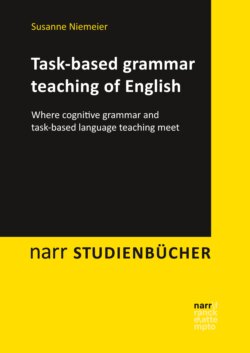Читать книгу Task-based grammar teaching of English - Susanne Niemeier - Страница 14
На сайте Литреса книга снята с продажи.
2.2 The task cycle
ОглавлениеWhen planning a task, a teacher not only has to keep the target group’s interests, age and level of language skills in mind but also needs specific abilities. SKEHAN (1996, as quoted in MÜLLER-HARTMANN/SCHOCKER-VON DITFURTH 2011: 87) lists these as a) “an ability to select and sequence tasks for supplementary activities”, b) “the competence to organise, appropriately, pre- and post-task activities”, c) “a willingness to adapt task difficulty during the actual task phase” and d) “a sensitivity to individual differences and the capacity to adapt tasks to take account of differences in learner orientation”. In other words, not only do teachers have to be able to creatively plan and prepare tasks with their target audience in mind, but they have to show a certain degree of flexibility to adapt the task if it works out differently than planned.
KUMARAVADIVELU (2007: 20) even claims that “the biggest methodological challenge facing the classroom teacher is to cope with the unpredictable nature of task performance”. This means that teachers need to be prepared for alternative task results than those they originally had in mind and they need to be able to reorganise their lessons to a certain extent if the task takes longer than planned or, vice versa, if the learners work faster than expected. For example, it is of utmost importance never to leave out the report phase, even if time is running out, as the learners definitely need feedback and evaluation. Therefore, in some cases, the remainder of the lesson needs to be restructured so that, for instance, parts of the task can be left out in order to have enough time for the reports and the teacher’s ensuing feedback.
Language learning is no linear process and therefore there is no ideal way of learning for just about everybody. All learners bring with them individual, cognitive and motivational differences, which can only be catered for if the teacher sets meaningful tasks and promotes motivating activities in which the foreign language is used. Every learner may gain slightly different outcomes and advancements of their respective interlanguage from such tasks and there will never be completely unified results.
When planning a task-based lesson, the easiest way is to rely on an established framework. Various methodological designs exist, which all have in common that they consist of three main phases (pre-task, during-task, post-task). The best-known three-phase model comes from WILLIS (1996), who has developed a generalizable framework for task-based language teaching which has been widely accepted and which will also be followed by this book, although it will be modified at some points. The framework allows for creativity and variety in all of its phases. WILLIS uses the term “task cycle” for the middle part (which includes the actual task, the planning of the learners’ reports and the reports themselves), but many other researchers (such as, for example, NUNAN 2015) use the term “task cycle” for the complete framework, which – as has already been indicated – consists of three main stages, the middle stage being divided into three further sub-stages. This book follows NUNAN’s way of using “task cycle” for the complete model.
Usually, a task cycle takes up one lesson. It is, however, possible that a lesson may consist of several task cycles (what NUNAN calls “several linked tasks or task chains”, 2015: 12) or else, that a task cycle can span over several lessons. With one exception (the case study on verb complementation), the examples provided in the second part of this book all take up one lesson each.
